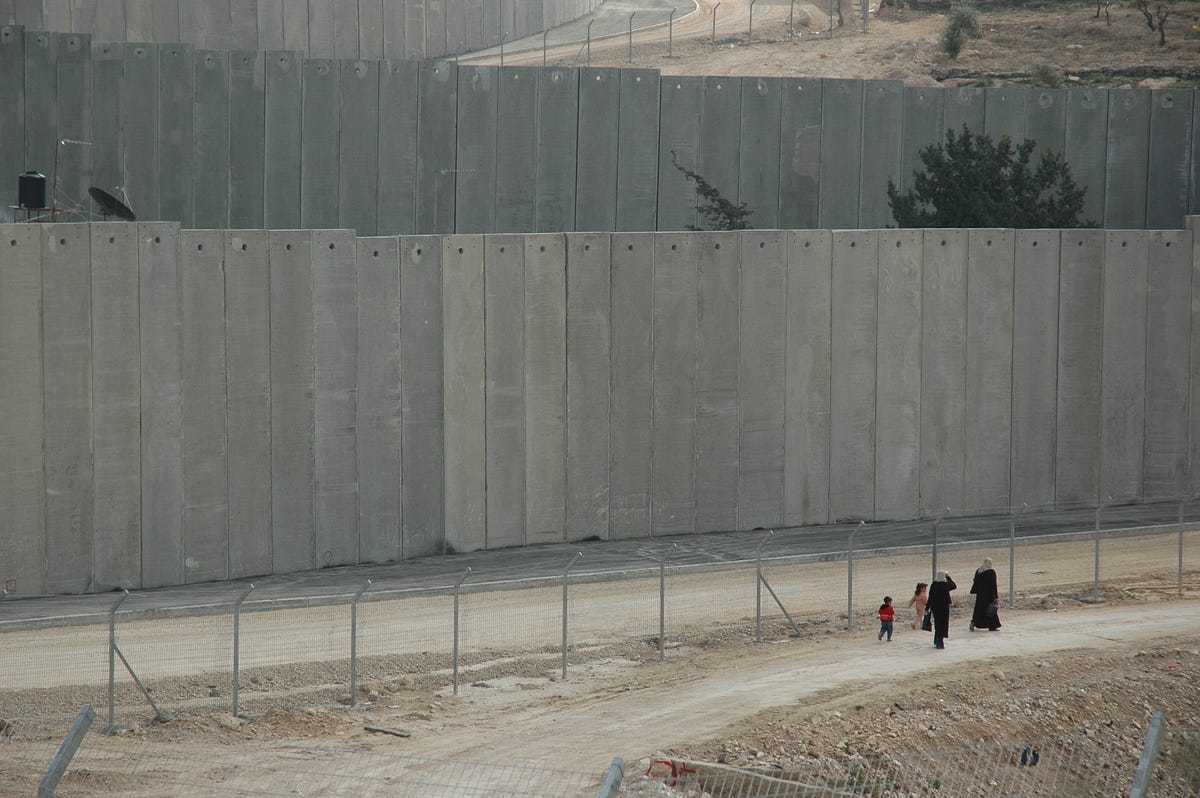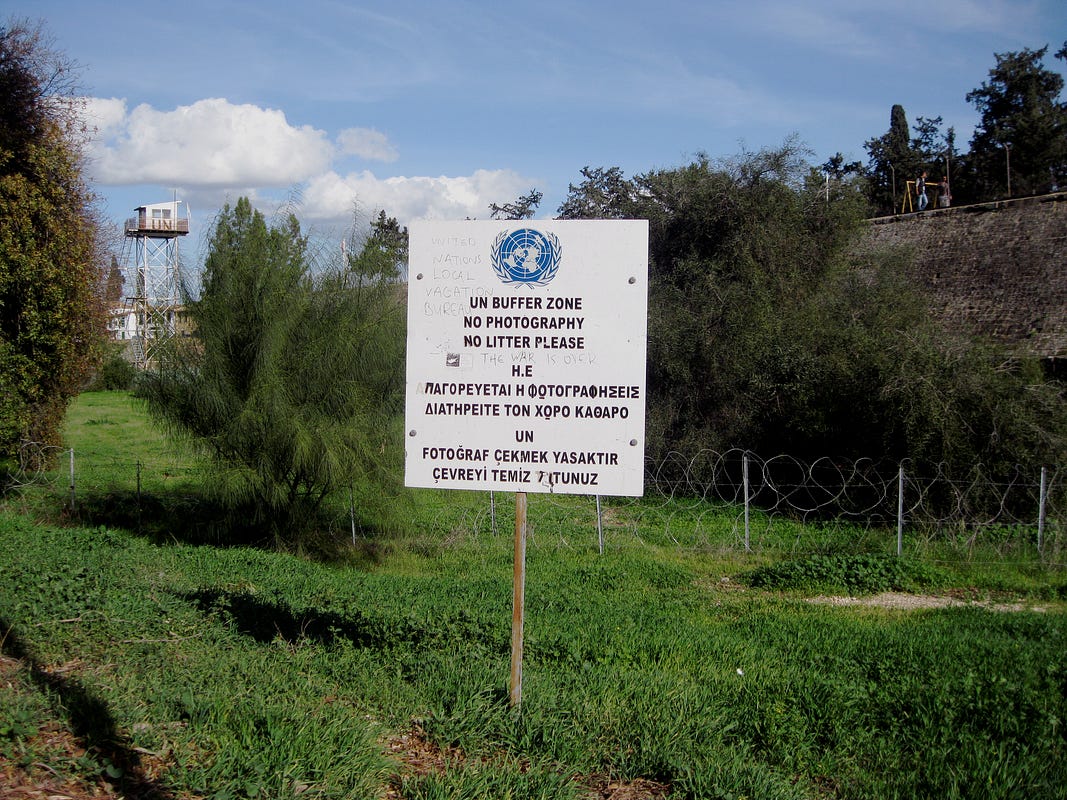Exploring No-Man’s-Land in the 21st Century — War is Boring — Medium.
 Barrier walls in the Palestinian territories in 2004. Lisa Nessan/Flickr photo
Barrier walls in the Palestinian territories in 2004. Lisa Nessan/Flickr photo
Following the end of World War I, Europe’s intellectuals tried to understand and explain what everyone just went through. They also tried to grapple with the reality of industrialized warfare and the no-man’s-lands it created.
Blasted, blown up and raked by machine gun fire. The no-man’s-land was a place that people couldn’t go without risking death.
Some thinkers on the political left saw no-man’s-land as symbolic of the destruction of Europe’s dying, traditional political order. However, intellectuals on the right saw the battlefield as a place where young men could be reborn into the fascist shock troops of Weimar Germany.
The fixed trenches of World War I are long gone. But the no-man’s-land never really went away, according to Noam Leshem, a political geographer at Durham University in England who studies modern no-man’s-lands.
From Cyprus, Western Sahara, the Palestinian territories to the Korean peninsula, no-man’s-lands are now tourist attractions, environmental preserves and places to make money.
Leshem’s work is available at Re-Inhabiting No-Man’s Land, a collection of writing and research on modern dead zones.
[…]
Our concern began with the obvious no-man’s-land of the First World War, but Alasdair reminded me the term was constantly being circulated in reference to very different sites.
So anything from other geopolitical areas like the demilitarized zones between the Koreas, the Chernobyl Exclusion Zone, or even urban geopolitical no-man’s-lands like the one that divided Jerusalem until 1967.
But even beyond the geopolitical vocabulary, what we saw was that no-man’s land entered our lingo to refer to anything from gangland in the heart of North American cities to tax havens in the Caribbean.
When we started looking into this, one of our key goals was to try and understand the history of the term, and to our surprise the term is much older than 1915, i.e. the Battle of the Somme. It dates back to the 14th century and to London during the months preceding the plague, when the bishop of London buys a lot of land outside the city to prepare a mass grave ahead of the bubonic plague.
We found that relationship between a space and death to be kind of one of the key characteristics of no-man’s-land throughout its history. And what we’re trying to do today is two things, is first is continue to understand the history of the term beyond its sort of Anglo-Saxon origins, but also ask what do no-man’s-lands in the 21st century mean?
RB: We often think no-man’s-land as a sort of desolate environment. But in the Cyprus buffer zone there’s actually a lot of stuff going on there.
NL: Absolutely. Cyprus is a great example. As you know, there’s a lot of economic activity. There’s a lot of farming going on in the designated U.N. buffer zone, but you also get newly constructed industrial zones that are rezoned by the U.N. for civilian use.
So what you get are sub-civilian spaces within the militarized space of the buffer zone designated for economic activity.
In addition you get a lot of smuggling—of drugs, people across the no-man’s-land. And I would add to that: tourism. The buffer zone in Cyprus has become one of the key tourist attractions on the island. Beaches, good food and you get some buffer zone watchers.
So absolutely this is a very significant space economically and a space that is constantly inhabited, governed, monitored and practiced.
There are things happening in it that makes it a significant space rather than just this empty no-go zone.
RB: There’s also environmental features to these spaces. The demilitarized zone in the Koreas is a famous wildlife sanctuary.
NL: Here’s a funny anecdote from when we were in Cyprus a few weeks. One of our interviewees told us that Cypriots just absolutely love hunting, and although most of the wildlife on the island is completely extinct, he said if you want to find snakes, go to the buffer zone. If you want to find wildlife, go to the buffer zone.
That’s the only place where animals have survived because hunting is not allowed there.
As you pointed out, the demilitarized zone between the Koreas is a very important Asian wildlife sanctuary. Chernobyl is famous for the resuscitation of natural habitats as a result of the withdrawal of human activity. The herds of wild horses that roam Chernobyl these days have become almost as famous as reactor number four.
However, there’s again an interesting history because in 19th century notebooks of expeditions in North America, we find repeated references to the no-man’s-land as a space between two warring tribes where wildlife game finds refuge.
So already that association between sanctuary and no-man’s-land is made long before we designated the demilitarized zone in the Koreas as a sanctuary or the inadvertent creation of a wildlife sanctuary in Chernobyl.
There’s a fantastic film on the community of bunnies that found refuge in Berlin between the two sides of the wall. So in the no-man’s-land in Berlin, there was a huge community of bunnies.
It’s really important issue. It sheds light on the interests that preserve these spaces. I think that’s not just about preserving these spaces for the future, but the sense that the spaces are still a part of human concern.
RB: You had a recent post on your blog about [German war veteran and writer] Ernst Juenger. What were you trying to do there?
NL: Juenger was one of the most important thinkers that repeatedly returns in his writing and thinking to the no-man’s-land. The no-man-land’s for Juenger—contrary to the traditional definition of it as this desolate no-go zone—is a very productive space.
The no-man’s-land is a space from which a new man emerges, a man that has fused with machine and with earth to create this new—almost cyborg—creature that has bettered himself to such an extent that he is a new kind of being.
Not only is this happening on an individual level, but also on a social level. He talks about there being a “community of the trenches.”
But it’s important to remember that Juenger was part of a very specific intellectual group traditionally positioned on the right in Weimar Germany that celebrated the no-man’s-land, that romanticized it. On the other side, still in Weimar Germany, we see people like Walter Benjamin.
Benjamin was exempt from military service in the First World War, but he constantly returns to the no-man’s-land as a space where a philosophical crisis happens. Benjamin repeatedly asks, what’s the meaning of this space of destruction?
[…]
In the Second World War, that is transplanted from the trenches to the enclosed space of the gas chamber, or remotely through aerial bombardment. And what we have here is a change in status and no-man’s-land is no longer applied to concrete spaces of warfare and death.
 The U.N. buffer zone in Cyprus in December 2012. Athena Lao/Flickr photo
The U.N. buffer zone in Cyprus in December 2012. Athena Lao/Flickr photo